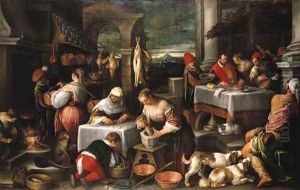Gerolamo Bassano Paintings
Gerolamo Bassano, born in 1566 in Bassano del Grappa, Veneto, Italy, was part of the illustrious Bassano family, a dynasty of painters who left a significant mark on the Venetian Renaissance art scene. He was the third son of Jacopo Bassano, one of the most prominent members of the family, known for his unique blend of Renaissance and Mannerist styles. Growing up in a household steeped in artistic tradition, Gerolamo was trained by his father alongside his brothers, Francesco, Leandro, and Giovanni Battista, all of whom would go on to become accomplished painters in their own right.
Gerolamo’s work, though not as widely recognized as that of his father or brother Leandro, nonetheless exhibits the family’s characteristic attention to detail, vibrant use of color, and a keen interest in naturalistic scenes. His oeuvre includes religious subjects, landscapes, and genre scenes, demonstrating versatility and a deep understanding of the Venetian painting tradition. Gerolamo contributed to the family workshop's productions, often collaborating on larger commissions, which was common practice among the Bassanos. This collaborative approach sometimes makes it challenging to attribute specific works to Gerolamo with certainty.
After his father Jacopo’s death in 1592, Gerolamo, along with his brothers, continued the operation of the family workshop, ensuring the Bassano legacy endured through the late 16th and early 17th centuries. His works, though perhaps more subtle and less frequently encountered in major museum collections than those of his relatives, reflect a continuation of the family’s artistic principles, emphasizing naturalistic representation and a warm, luminous palette. Gerolamo Bassano’s contribution to the family’s artistic enterprise helped maintain the Bassano name as synonymous with high-quality Venetian art during a period of significant transition and innovation in European art. He passed away in 1621, leaving behind a body of work that, while sometimes overshadowed by his family’s more famous members, remains an integral part of the Bassano legacy.
